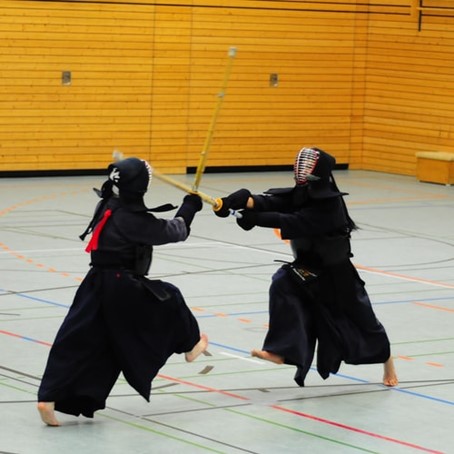
Kumdo (Korea)
- Name of sport (game): Kumdo
- Place of practice (continent, state, nation):
Korea
- History:
Kumdo (Gumdo) means “the way of the sword”.
Kendo is Japanese fencing whereas Kumdo is Korean fencing. They differ in that Kendo is more strategic as practitioners seek the “perfect strike.” Kumdo, on the other hand, is more aggressive in nature, as practitioners proactively draw out their opponents.
Kumdo is Korean. But it’s derived from Kendo, a Japanese martial art form. In the late 1800s, Kendo was introduced to Korea by the Japanese as one of the ways to train the police. But in time, it morphed into Kumdo, a Korean art form with a distinctive flavor that makes it different from its ancestor.In the fourth century of the Common Era a new system of metallurgy was introduced to the Korea Peninsula from China. This introduction gave birth to a new and superior weaponry. Previously, the bow and the staff had been the primary tools of warfare. With the introduction of refined metal crafting, the sword took on new importance. This was because of the fact that this new metallurgy made the sword a much more reliable weapon, as it became more difficult to fracture during battle.
At this juncture of history, Korea was divided into three warring kingdoms: Koguryo, Silla, and Paekche. Due to this fact, beginning in the fifth century C.E., formalized groups of warriors came into existence on the Korean Peninsula. These warriors embraced Buddhism and devoted themselves to the cultivation of moral values, based in Confucian ideology. These warriors took martial warfare to a new and much more refined level of understanding than had been previously embraced. Among these armies were the Kyong Dang of Koguryo and, most notably, the Hwa Rang of Silla.
The Hwa Rang were formed during the reign of King Chin Heung. They were an elite, warrior corps, made up of young noblemen. These warriors trained their bodies and minds in all forms of martial understanding. The Hwa Rang, through refined military strategy, defeated their neighboring armies and unified the three Korean kingdoms. Throughout history, Korea has looked to the Hwa Rang for inspiration for the martial art tradition.
As the sword became the key instrument of close contact warfare, it was one of the Hwa Rang's primary weapons. The techniques of the Korean sword, at this period of time, were stylistically formalized into twenty-five poses and postures that would most rapidly result in an opponent's demise.The Philosophy of Kum Do: “Kal-deung is the sky and Kal-nal is the land, therefore Kal itself produces the combination of Um and Yang (Yin and Yang). Son-jap-yi is a king and Kal is the subject to the king’s will. Abusing Kal could cost one’s life, therefore, there should be Do (Way) when handling Kal (Sword).
That is Kum Do.” Kum Do is traditional Korean swordsmanship, which is more than a sport. It is a form of art that is considered both a discipline as well as a sport. Kum Do is both physical and psychological training. First of all, with Kum (sword), one can practice to improve one’s physical fitness, by practicing various attacks, blocks and forms. Do (the Way) helps control one’s mind and inner desire. All Kum Do activities help growth of muscle, bone and enhance vital energy. Kum Do is a way to defend oneself with physical improvement and regulation of one’s health and longevity.
Throughout Korean history, various swords techniques were practiced by both men and women. At one time in Korea, women were allowed to practice only with a palm-sized knife, Eun-jang-do, for self-defense. Today, however, Kum Do is practiced by men, women, and children of all ages and abilities. Kum Do practice at Kang’s Martial Arts emphasizes discipline, mental and physical skill as well as health and conditioning.
Kum Do forms is like a sword dance, which is based off ancient Korean traditions. Forms are essential to teaching proper technique, body posture, and balance. Kum Do sparring gives the student a chance to apply sword technique in actual combat situations in a safe way. Bamboo swords are used to strike targets and in sparring matches where armor is worn to prevent injury.
- Description:
"Kumdo," literally means, "Sword Way." Kumdo is a Korean translation of the Japanese term, "Kendo." "Ken" meaning, "Sword," and, "Do" meaning, "Way."
The Korean art of Kumdo is a direct interpretation of its Japanese counterpart. In fact, some of the early founders of Kumdo claim that there is absolutely no difference between the two arts.The parallels between Korean Kumdo and Japanese Kendo can not be overlooked as one comes to define this art. Though Kumdo possesses its own cultural identity, the correlation between the two arts is very clear.
To begin to see the influence Kendo has had upon Kumdo, one need only look at the uniform. Most Kumdo schools wear the same clothing as their Japanese counterpart. The Kumdo practitioner wears the "Hakama," the large pleated pants. Kendo armor, known as, "Hoogo," in Korean is also commonly worn during competitions.
Hoogoo is made up of the, "Ho Myun," head and face protector. "Gap," which protects the chest. "Ho Wam," which protects the hands. "Gap Sang," which is the apron which protects the waist and groin.
The Kendo bamboo sword, known as, "Shinai," in Japanese and "Juk Do," in Korean, is a key element of partner practice in Kumdo. The wooden sword, "Bokken," in Japanese and "Mok Kum" in Korean, is also a common training tool.
The practitioner of Kendo uses a long samurai sword or "Katana" for these drawing and striking techniques. The Kumdo practitioner performs his techniques with a long steel sword known in Korean as, "Jung Kum."
The basic difference between the Japanese and the Korean long sword is that the katana possesses a slight arch. The jung kum, on the other hand, is oftentimes straight. The use of the jung kum is not universal in Kumdo, however, and the Japanese katana oftentimes replaces it.
The straight design of the jung kum was brought into utilization predominately by the modern Korean systems of Kuk Sul Won and Hwa Rang Do. Both of these systems possess a more Chinese influenced art of swordplay than does Kumdo. Though the straight sword is now commonly associated with the Korean arts, in the Moo Yeh Do Bok Tong Gi, the long swords are detailed as possessing the same arch as those used by the Japanese Samurai.
When one begins the practice of Kumdo, the primary focus is placed upon "Iwa Sae" or proper stance. It is understood that without a proper stance no sword technique can be performed efficiently. Therefore, extensive emphasis is placed on this element of Kumdo training.
The "Tanjun," more commonly known by the Japanese term, "Hara," is understood to be an individual's center of gravity. This bodily location exists approximately four inches below the navel.
In Kumdo, it is understood that all sword techniques must be launched with a consciousness placed on this bodily location or the practitioner will easily be set off balance by his sword. From a more metaphysical perspective the tanjun is also understood to be the location where ki, "Internal energy" congregates. Thus, this location is quite revered.
Human breath is known to be the link to ki. Thus, a Kumdo practitioner always breathes in ki and mentally directs it to his tanjun at the outset of each sword movement. When the sword is unleashed, this ki filled breath is released with a, "Kiap," a martial arts yell. This signals that ki is being expelled as the sword moves towards its target.In Kumdo, the sword is held with your lead hand placed just under the sword guard. In some designs the jung kum possesses no sword guard. In these cases, your lead is placed in the same location, at the upper region of the sword's handle. Your rear hand is located at the bottom of the sword's handle. From this grasp, maximum control is maintained over the sword.
In certain Kumdo techniques, the sword is wielded with one hand. In this case, the hand holding the sword remains close under the sword guard. Thus, maintaining maximum balance and control over the sword.
When the jung kum is held, your elbows should remain slightly bent. This is true in all Kumdo drawing, ready position, and striking techniques. From this, you allow your arms to remain loose. Thus, possessing the ability to readily direct or redirect your sword technique with speed and accuracy.
In Kumdo, as with Iaido, the primary focusing technique witnesses the practitioner precisely draw the sword and unleash a highly defined striking technique. In Kumdo, once the sword has been unsheathed, these defined strikes often times include the use of the sheath as a blocking tool. This use of the sheath, as a defensive weapon, is one of the factors, which separates Kumdo from most schools of Iaido.All techniques used in Kumdo are based in eight primary strikes:
1) Overhead Strike, Straight
2) Overhead Slash, Left Side
3) Overhead Slash, Right Side
4) Side Slash, from the left
5) Side Slash, from the right
6) Under Slash, from the left
7) Under Slash, from the right
8) Under Body StrikeVariations are added to these techniques as the Kumdo practitioner becomes more advanced with his use of the sword.
Sword Strikes
In Kumdo the strike of the sword is never over extended. The practitioner must always control the blade as opposed to being controlled by its weight and momentum. This is accomplished by never randomly striking at the imaginary targets. All strikes are performed consciously with precise impact points in mind.
The development of proper sword strike ability is achieved through conscious practice and proper technique. A sword, in practice, is always extended with the same intent or controlled force that would be used in a true confrontational situation. It is a misnomer that a sword is wielded with a different intensity when one is defending against an imaginary opponent or a real object.Kumdo sword strikes are made in linear fashion. That is to say, they are performed in a straight to the target pattern. Whenever a strike is performed with the sword, it is quickly and precisely snapped into its final position. The sword techniques are not ornamented or flashy. And, no unnecessary energy is used when they are performed. This is where Kumdo differs from some of the Chinese schools of swordplay.
As is the same with the kicking and punching techniques indigenous to Korea, all sword strikes are not ended at the beginning of the target. They are, instead, performed in an application that would penetrate and go through said target. This implementation does not negate the previously mentioned conscious impact point. What it does entail is that the Kumdo swordsmen learns how much impact must be delivered in each sword application to penetrate their intended target.
All Kumdo sword strikes are precisely implemented movements. Through continued practice the swordsman comes to the understand how each sword technique is most efficiently performed. This is accomplished by observing how much force is used in each sword technique, where that energy is most effectively focused, and how much power it will take to achieve the desired result. All of this come from continued practice and developed understanding.The practice and development of Kumdo relies heavily upon forms training. Forms are known by the Korean word, "Hyung." Specifically Kumdo forms are referred to as, "Bon Kuk Kum Bop."
There are ten primary forms that are used in Kumdo. With in these forms, the majority of all the sword techniques are used and then integrated with the various applicable foot and hand techniques.
In many schools of Kumdo, the techniques of the sword are integrated with the weaponless fighting styles of Korea. For example, kicks and to a lesser degree, hand strikes are incorporated into all methods of sword practice. This is particularly the case of the hyung of Kumdo.Kumdo Vocabulary
Juk do - bamboo sword
Jung Kum &endash; Long sword
Kal - sword or knife
Kal geut - tip of the blade
Kal jip - sheath
Kum - sword
Kumdo - way of the sword
Kum sool - term for sword skills
Mok kum - wooden practice swordSource: Scott Shaw, Just How Korean is Korea's Way of the Sword, Black Belt Magazine, May 2000
Equipment - common types of equipment used in Kumdo include the following:
Myŏn-soo-goon -- a lightweight scarf, typically mad of cotton, that's worn under the helmet for protection.
Homyeoum -- wire-mesh helmet that's worn to protect the face.
Kap -- a protective vest worn over the torso.
Kapsang -- type of canvas and leather skirt worn to protect the lower body.
Howan -- protective mitts with side cuffs.
Ko-dûng-i -- the hilt of a sword, used to protect the hands.
Duengjul -- yellow-colored string attached to the sword's tip and guard.
Joonghyuk -- leather band that marks the "striking" area of the sword.
Sunnhyuk -- leather cap, representing the tip of the sword.
Byounghyuk -- Handle of the sword.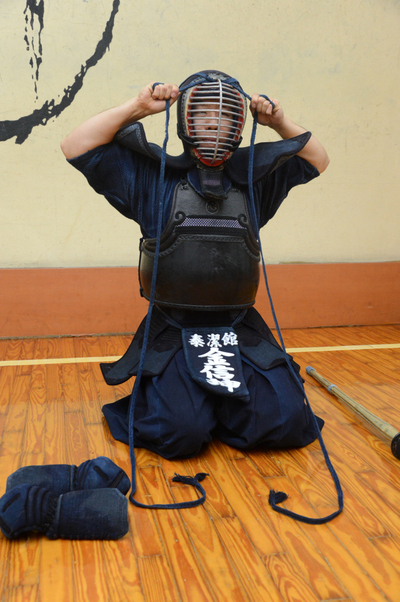
By: Chung Hee-cho/The Korea Herald - Current status:
Practiced
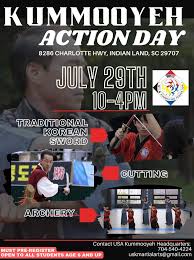
- Contacts:
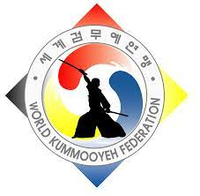
World Kummooyeh Federation
Web: https://kummooyeh.org/
World Kummooyeh Federation,
205, 100 Artcenter-daero 168beon-gil,
Yeonsu-gu, Incheon, South Korea 22006
Phone : +82 10 7551 1650
Email :This email address is being protected from spambots. You need JavaScript enabled to view it. ,This email address is being protected from spambots. You need JavaScript enabled to view it.
Fb: https://www.facebook.com/groups/302869703112650/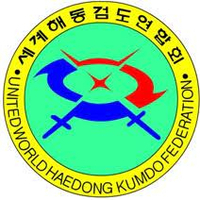
United World Headong Kumdo Federation
E-mail:This email address is being protected from spambots. You need JavaScript enabled to view it.
Web: http://www.haedongkumdo.co.kr/
Fb: https://www.facebook.com/jinyoungssangkum/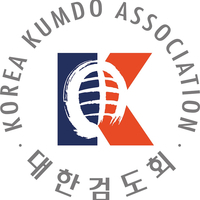
Korea Kumdo Association
Tel. 02-420-4258
Fax. 02-420-4350
Web: https://www.kumdo.org/
Youtube: https://www.youtube.com/channel/UClHvN16J4gBVj8i6p0lvhkQ/about - Sources of information :
Books:
Grand Master Edward Jacobsen, Haedong kumdo, volume 1, The ultimate guide to the korean sward martial art, Jacobsen - Randfontein, 2007Articles:
Scott Shaw, Just How Korean is Korea's Way of the Sword [in] Black Belt Magazine, May 2000
https://dojolifehq.com/kendo-vs-kumdo/?utm_content=cmp-true
https://kenjutsu-ryu.livejournal.com/20462.html
https://mas-swords.myshopify.com/blogs/articles/6-things-you-didnt-know-about-korean-kumdo?shpxid=094984ea-f133-4a07-b518-1aa978362474
https://www.swordsofnorthshire.com/blog/kumdo-vs-kendo-what-is-the-difference
https://www.kumdo4us.com/about-kumdoVideo:
https://www.youtube.com/watch?v=2mG4A7Sr1fU
https://www.youtube.com/watch?v=Z-MHsyXCB_g
https://www.youtube.com/watch?v=-0JVZu_-TSQ
https://www.youtube.com/watch?v=0WMRDnacDdQ
https://www.youtube.com/watch?v=LWIs6zw5lxM
https://www.youtube.com/watch?v=E3ai-IYKajw
https://www.udemy.com/course/kumdo-beginners/The information contained in the article comes from the following sources:
https://dojolifehq.com/kendo-vs-kumdo/?utm_content=cmp-true
https://kenjutsu-ryu.livejournal.com/20462.html
https://mas-swords.myshopify.com/blogs/articles/beginners-guide-to-kumodo?shpxid=d1fb9d27-a03c-4afb-88d6-bed5984c4b26Source of photos used in this article and gallery:
https://www.swordsofnorthshire.com/blog/kumdo-vs-kendo-what-is-the-difference
https://pl.pinterest.com/pin/281193570458162163/
https://m.koreaherald.com/view.php?ud=20131018000741
https://www.campus.sg/kumdo-korean-art-of-swordfighting-campus-sg/
https://mireumartialartsusa.com/kumdo-history/
https://northmnsword.wordpress.com/2018/02/18/welcome-to-kumdo/
http://www.kimstkdojang.com/kumdo-class-info/kumdo-what-is-it
https://www.groupon.com/deals/u-s-hwa-rang-kwan-kumdo
https://aprendecoreano.com/el-kumdo-o-hankumdo-de-corea/ - Gallery:

